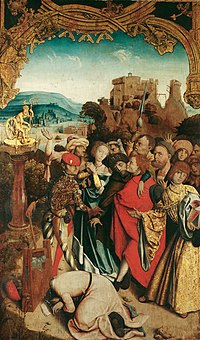Cantius, Cantianus, and Cantianilla
Saints Cantius, Cantianus, and Cantianilla | |
|---|---|
 Martyrdom of Cantius, Cantianus, and Cantianilla, from Krainburger Altar, 1510 | |
| Died | c. 304 AD Aquae Gradatae (San Canzian d'Isonzo) |
| Venerated in | Roman Catholic Church |
| Major shrine | San Canzian d'Isonzo |
| Feast | May 31 |
| Attributes | Cantius and Cantianus are depicted as two youths; Cantianilla as a girl; Protus as a tutor with a staff and faggot; sword; the group fleeing in a chariot; beheaded before an idol; palms and sword. |
| Patronage | children; Catholic youth |
Saints Cantius, Cantianus, and Cantianilla (all died May 31, circa 304 AD) are venerated as saints and martyrs by the Christian church.
Narrative
[edit]A late legend states that the three were orphaned siblings, members of a noble Roman family, the Anicii, and related to the Emperor Carinus.[1] Protus was their tutor or guardian, and the Christian who converted the three siblings.[2] When Diocletian began to persecute Christians, according to the legend, the four left Rome, selling their home and giving most of the proceeds to the poor.[3] They reached their estate in Aquileia, where they had travelled to visit in his prison the holy priest Saint Chrysogonus.[4] However, they were captured at a place called Aquae Gradatae (now called San Canzian d'Isonzo). They were beheaded after they refused to offer sacrifice to the civic gods.[5]
Veneration
[edit]A priest named Zoelus buried their bodies at the site.[1] Saint Maximus of Turin subsequently preached a panegyric in their honor, and the saints are also mentioned by Venantius Fortunatus. His testimony, which he could draw from coeval documents, is very reliable, and states only that they were brothers of blood and that they were martyred together not far from Aquileia, while they were leaving from there in a chariot. Their cult was anciently diffused in Lombardy, France, and Germany. A paleochristian basilica and tomb was discovered at San Canzian in recent times; it contained the remains of three individuals.[6]
References
[edit]- ^ a b "Cantianus, Saint", The Cyclopedia of Biblical, Theological, and Ecclesiastical Literature. (James Strong and John McClintock, eds.) Harper and Brothers; NY; 1880
- ^ "Martyrdom of *Cantius, Cantianus and Cantianilla", The Cult of Saints in Late Antiquity
- ^ "Sts. Cantius, Cantianus, Cantianilla, and Protus", FaithND
- ^ Monks of Ramsgate. "Cantius, Cantianus, Cantianilla, and Protus". Book of Saints, 1921. CatholicSaints.Info. 26 September 2012
 This article incorporates text from this source, which is in the public domain.
This article incorporates text from this source, which is in the public domain.
- ^ "St Cantianilla", The British Museum
- ^ "Santi Canzio, Canziano e Canzianilla".
